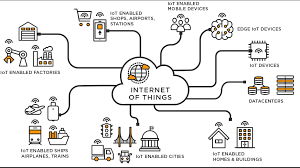Dive into the world of IoT, where everyday objects are interconnected, transforming the way we live, work, and interact with technology. Discover its potential, challenges, and how it’s reshaping industries.
Introduction
The Internet of Things (IoT) has emerged as a transformative force, connecting the physical and digital worlds in unprecedented ways. From smart homes to industrial automation, IoT is revolutionizing various sectors, promising efficiency, convenience, and innovation. This article explores the concept of IoT, its applications, challenges, and the future it holds.
Understanding IoT
At its core, IoT refers to a network of interconnected devices embedded with sensors, software, and other technologies that enable them to collect and exchange data. These devices range from everyday objects like smartphones, wearables, and home appliances to sophisticated industrial machinery and infrastructure.
Applications of IoT
- Smart Homes: IoT enables homeowners to automate and remotely control various aspects of their homes, from temperature and lighting to security systems and appliances. Smart thermostats, lighting systems, and voice-activated assistants like Amazon Alexa and Google Home are prime examples
- Healthcare: In the healthcare sector, IoT devices are revolutionizing patient care and management. Wearable devices can monitor vital signs, track medication adherence, and even alert healthcare providers in case of emergencies, enhancing patient outcomes and reducing healthcare costs.
- Industrial IoT (IIoT): In industries, IoT is driving the fourth industrial revolution, also known as Industry 4.0. IIoT enables manufacturers to optimize processes, improve efficiency, and reduce downtime by leveraging real-time data from sensors embedded in machinery and equipment.
- Smart Cities: IoT plays a crucial role in building smarter and more sustainable cities. From intelligent traffic management systems to waste management solutions and environmental monitoring, IoT technologies help cities improve infrastructure, enhance public services, and mitigate environmental challenges.
Challenges and Concerns
- Security: With the proliferation of connected devices, security emerges as a significant concern. IoT devices are vulnerable to cyberattacks, raising issues of data privacy, identity theft, and unauthorized access to critical systems.
- Interoperability: The lack of standardized protocols and compatibility among IoT devices hinders seamless communication and integration, posing challenges for scalability and interoperability.
- Data Privacy: The vast amount of data generated by IoT devices raises concerns about data privacy and ownership. Ensuring data security and implementing robust privacy measures are essential in building trust among users and stakeholders.
- Regulatory Frameworks: The rapid pace of IoT adoption outpaces regulatory frameworks, creating regulatory gaps and legal ambiguities. Establishing comprehensive regulations and standards is crucial in addressing issues related to privacy, security, and liability.
The Internet of Things represents a paradigm shift in connectivity, offering immense potential to transform industries, enhance quality of life, and address societal challenges. However, realizing the full benefits of IoT requires addressing various challenges, including security, interoperability, and data privacy. As IoT continues to evolve, stakeholders must collaborate to develop robust solutions and frameworks that promote innovation while safeguarding privacy and security.
Would you like to explore more such informative articles and blogs? We provide a range of informative articles across different domains. Subscribe today to be part of our community!


